|
|||
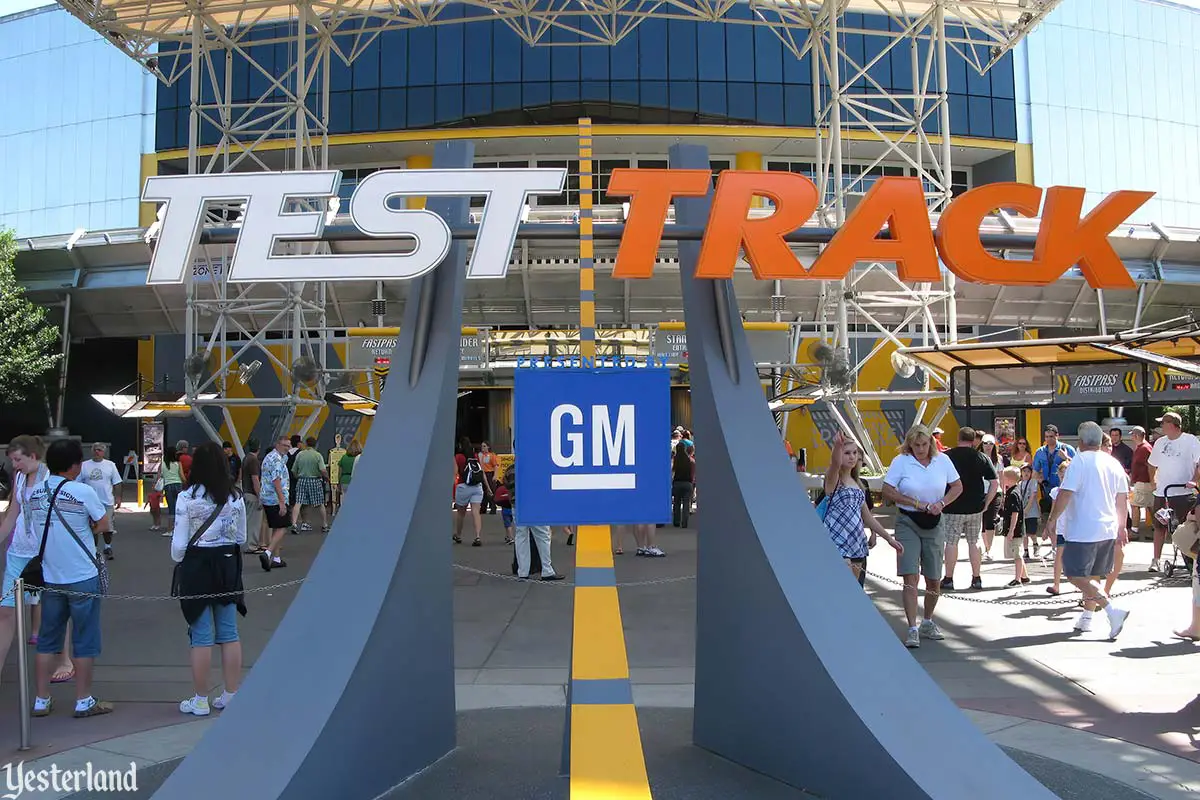
Photo by Werner Weiss, 2009 |
|||
|
Are you ready for a firsthand experience of what the world’s largest car manufacturer does to test their cars? Then enter Test Track, jointly designed by Disney and General Motors. |
|||
|
|
|||
|
Other attractions at Disney parks are populated by Audio-Animatronic people. This one has crash test dummies. Get ready to see broken windshields, damaged fenders, and even crumpled cars. |
|||
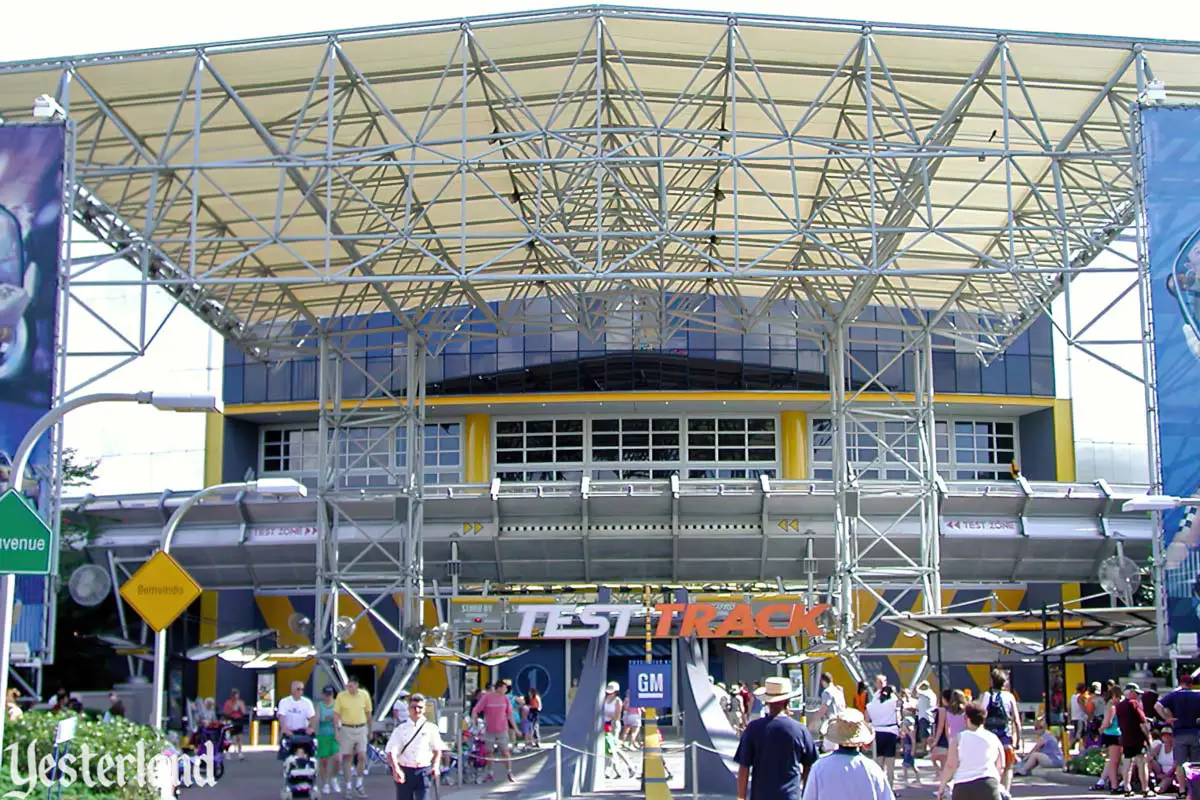
Photo by Werner Weiss, 2002 Test Track pavilion |
|||
|
It may seem that extolling the virtues of a car company by emphasizing car crashes makes as much sense as promoting an airline by showing airplane disasters. But the message here is that the sponsor designs cars for safety and performance — and thoroughly tests everything. Not only that, but a high-speed performance run on a proving ground track can be thrilling. Why should professional test drivers have all the fun? |
|||
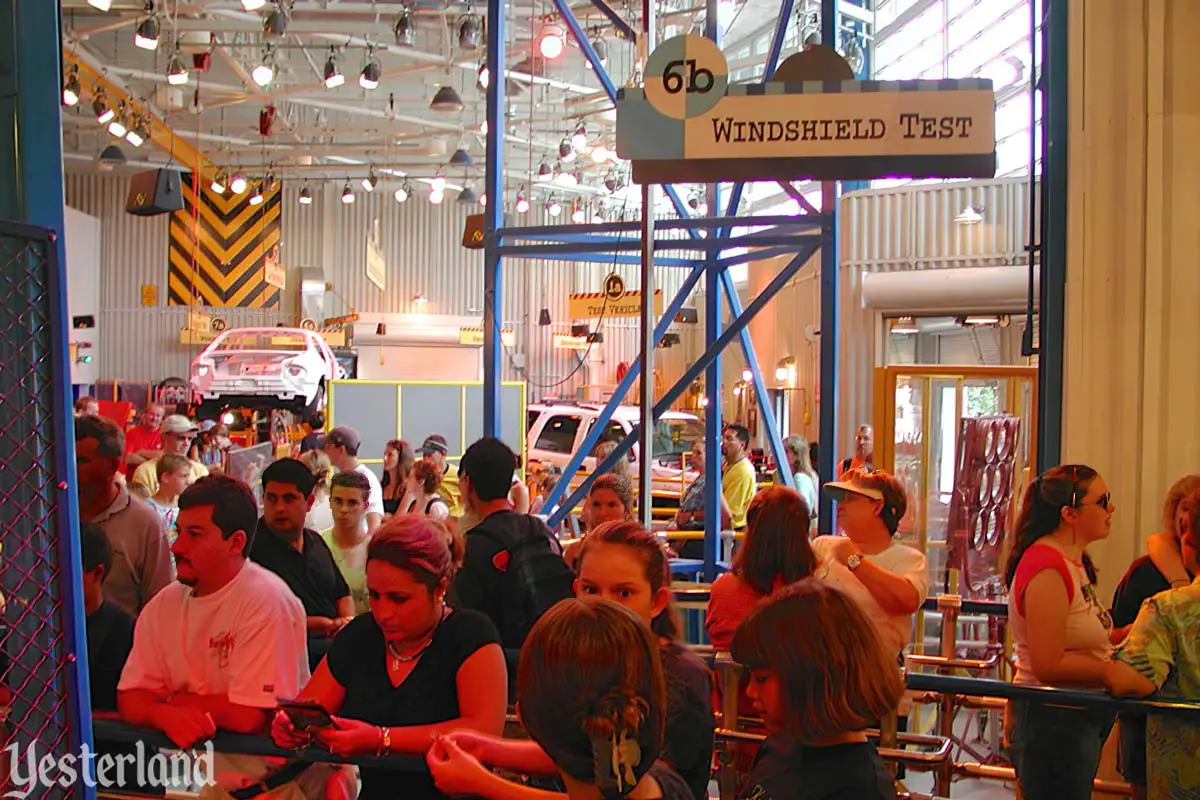
Photo by Werner Weiss, 2003 Queue demonstrating various tests |
|||

Photo by Werner Weiss, 2009 “Chest Calibration” test |
|||
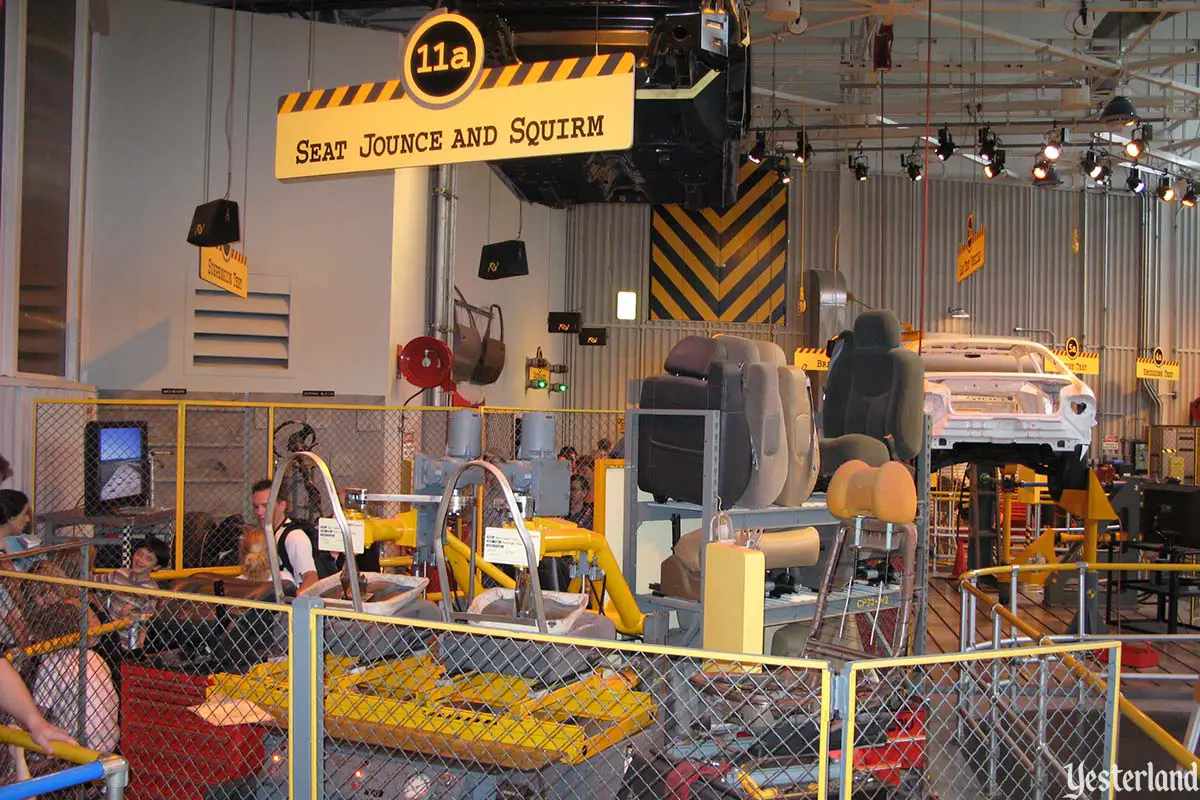
Photo by Werner Weiss, 2009 “Seat Jounce and Squirm” test |
|||
|
The standby queue goes past displays showing many different tests for safety, durability, and performance. There’s the air bag test, safety belt test, brake test, wheel test, corrosion test, door module cycle test, engine test, suspension test, and drop silo test — just to name a few. You might see a metal plunger repeatedly hit the chest of a crash test dummy. The seat jounce and squirm device simulates the abuse a car seat might get from years of use. It’s LOUD in here. Not only are some of the tests noisy, but there’s the loud, repetitive queue music, with its quick, pounding percussion. The FASTPASS and single rider queues take shorter routes. You don’t get to see most of the tests. |
|||
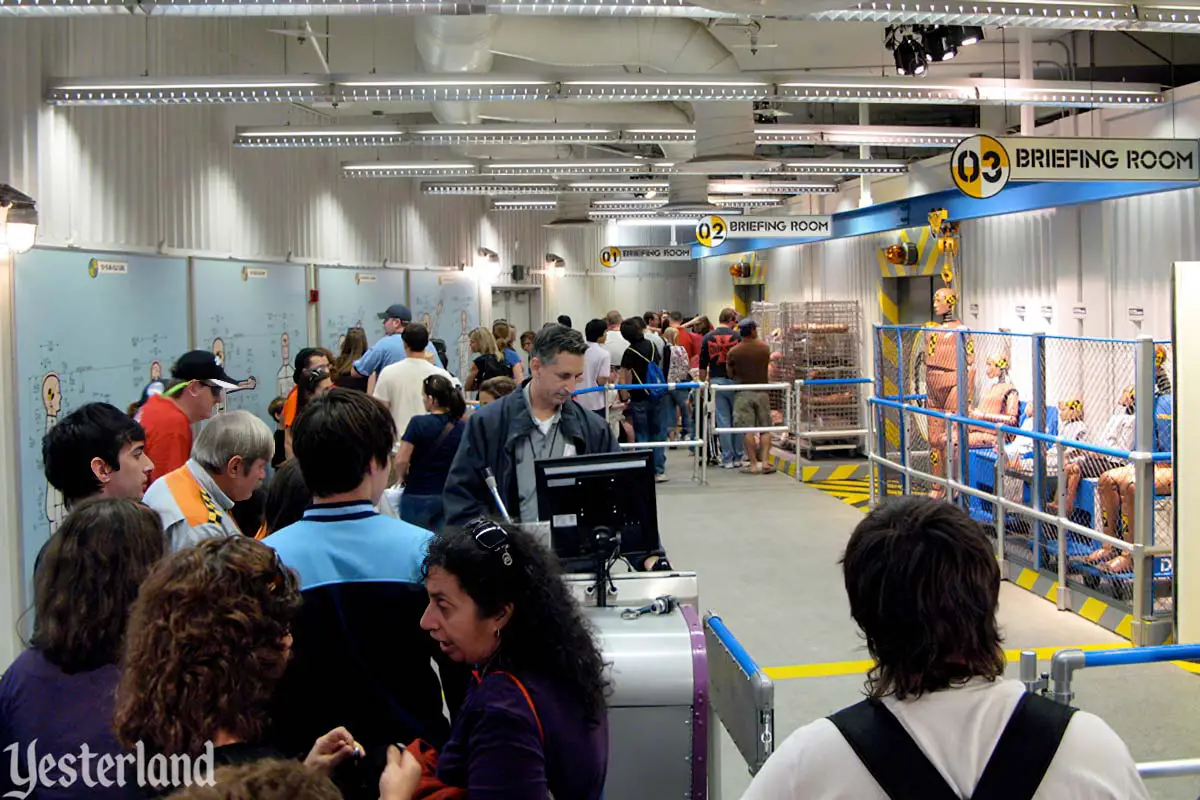
Photo by Werner Weiss, 2009 Waiting for your briefing |
|||
|
The next step is to wait for a briefing room. There are three of them. The waiting area is decorated with crash test dummies, crash test dummy parts, and crash test dummy diagrams. |
|||
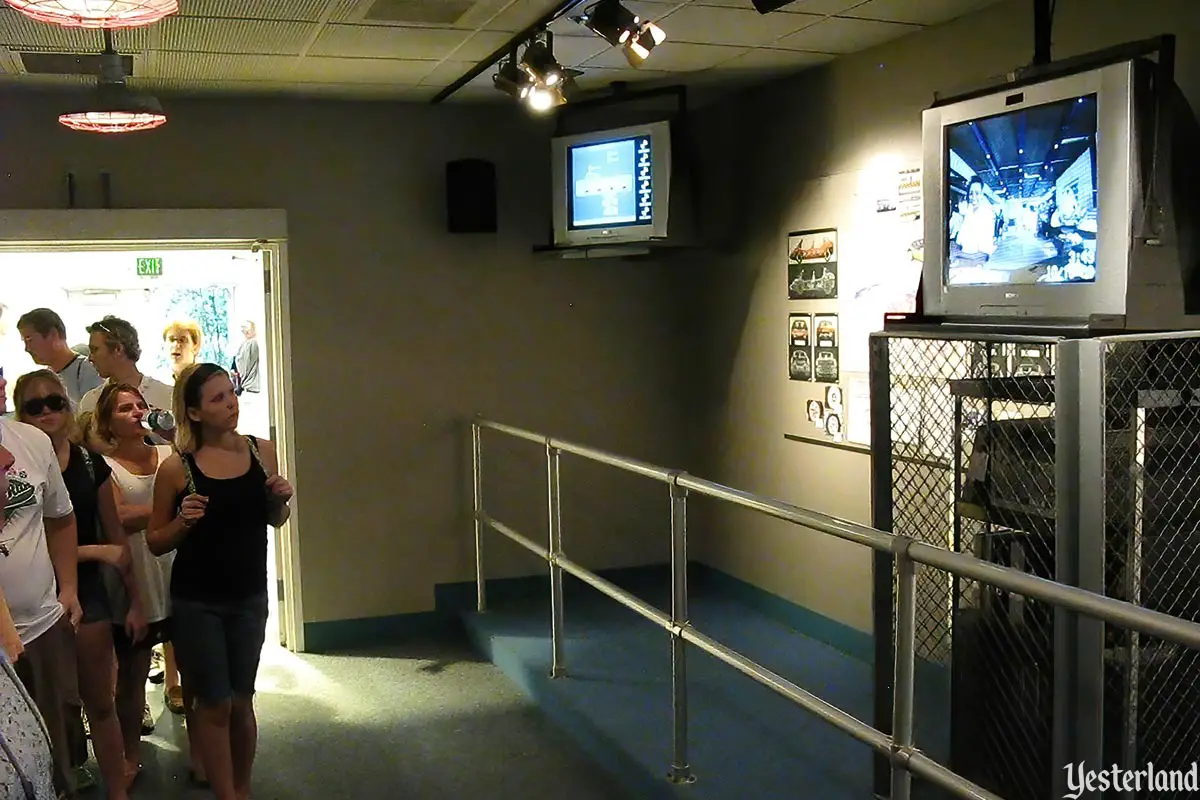
Photo by Werner Weiss, 2009 Briefing room |
|||
|
Enter a briefing room. The doors close. Sherry and Bill are now ready to present your briefing. It’s partially a ride safety spiel, partially an explanation of how the ride elements correspond to tests at actual proving grounds, and partially a pitch for GM. |
|||
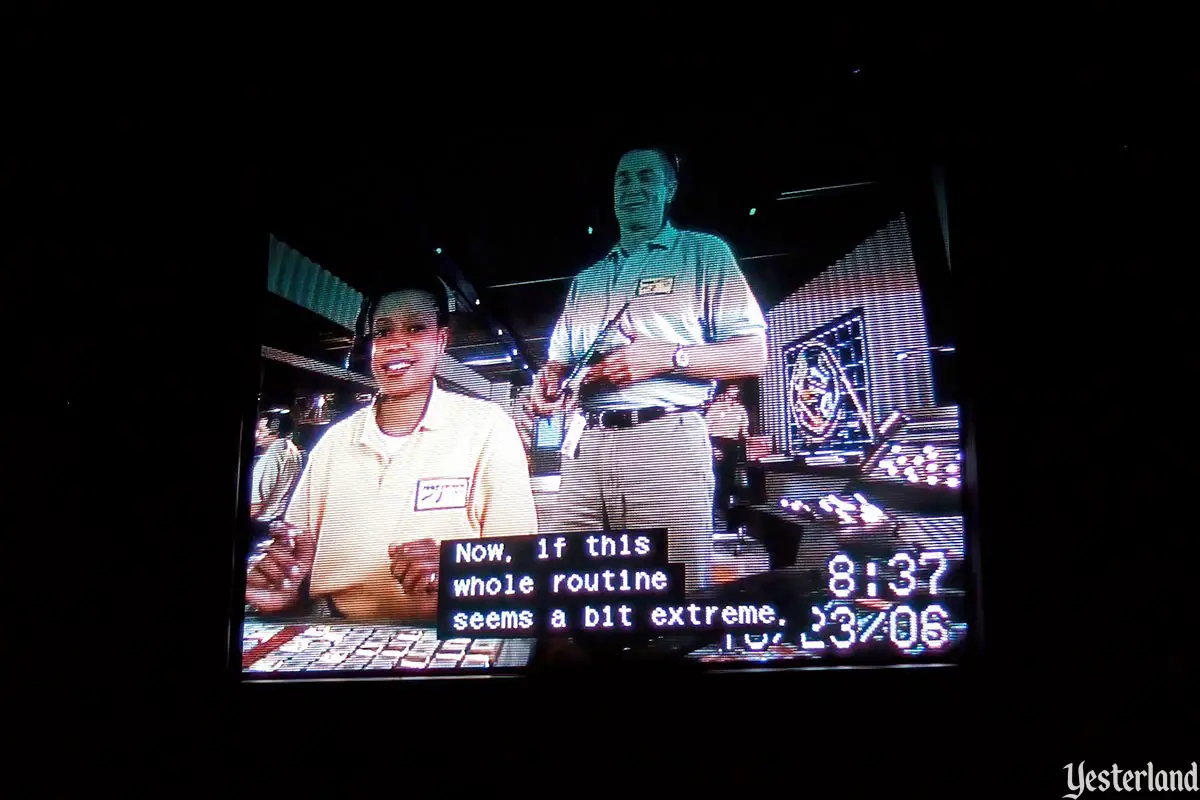
Photo by Allen Huffman, 2007 Sherry and Bill will explain what to expect. |
|||
|
The briefing concludes: Bill: Now, if this whole routine seems a bit extreme, you’re absolutely right — but that’s what a test track is all about. The cars you drive at home are made up of over 15 thousand different parts, and every one of them has to pass the test under very extreme conditions before we ever let it off that test track and out onto the road. Now, as you can imagine, safety is a big concern of ours, so we’re going to insist that you buckle up your safety belt securely. Sherry: You’ll be glad you did. Oh, we’re ready. Bill: Okay, great. Well, Sherry says we’re ready. So, we’ll see you out there on the Test Track. Sherry: Good luck. Have a good ride. The doors on the other side of the room open. |
|||
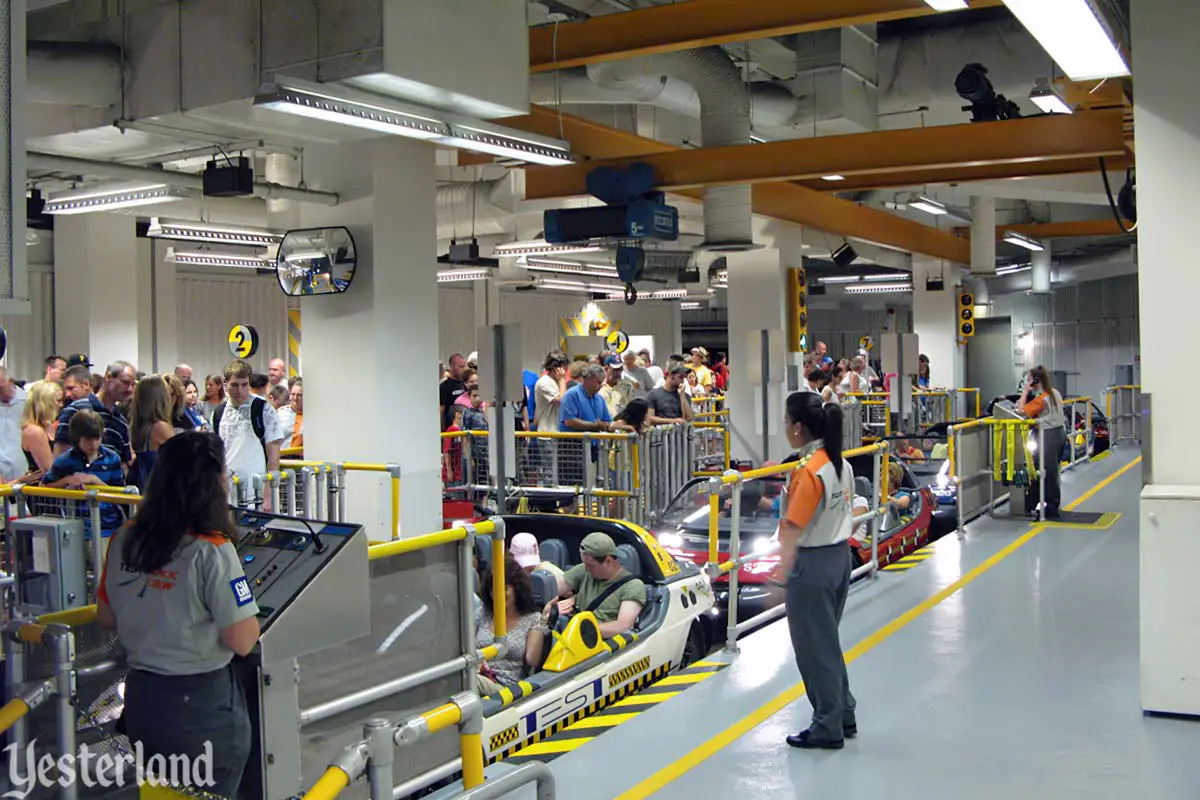
Photo by Werner Weiss, 2009 Three-plus-three seating |
|||
|
You’re now queued up for a car. Each car holds six guests — three in front and three in back. The cast members quickly and carefully assign guests to each row to minimize any empty seats. That’s good news for those in the single rider line, because there are plenty of times when the third seat in a row would otherwise be empty. |
|||
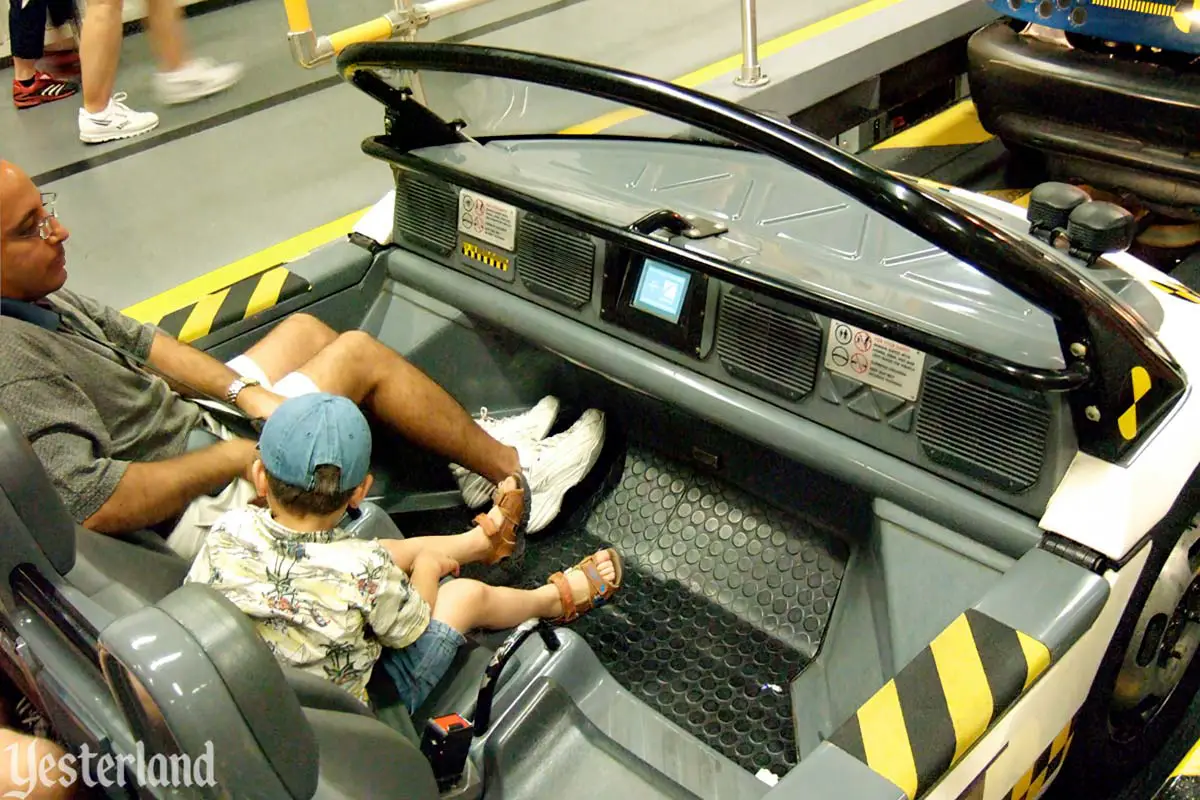
Photo by Allen Huffman, 2006 Buckle up |
|||
|
Safety belt fastened? You’re off! The first three vehicle tests are the hill climb test (climb to the level above the queue level), the rough road test (Belgian blocks are bumpy), and the brake test (ABS lets you keep control of the vehicle when braking). Next, you go through three environmental chambers. |
|||
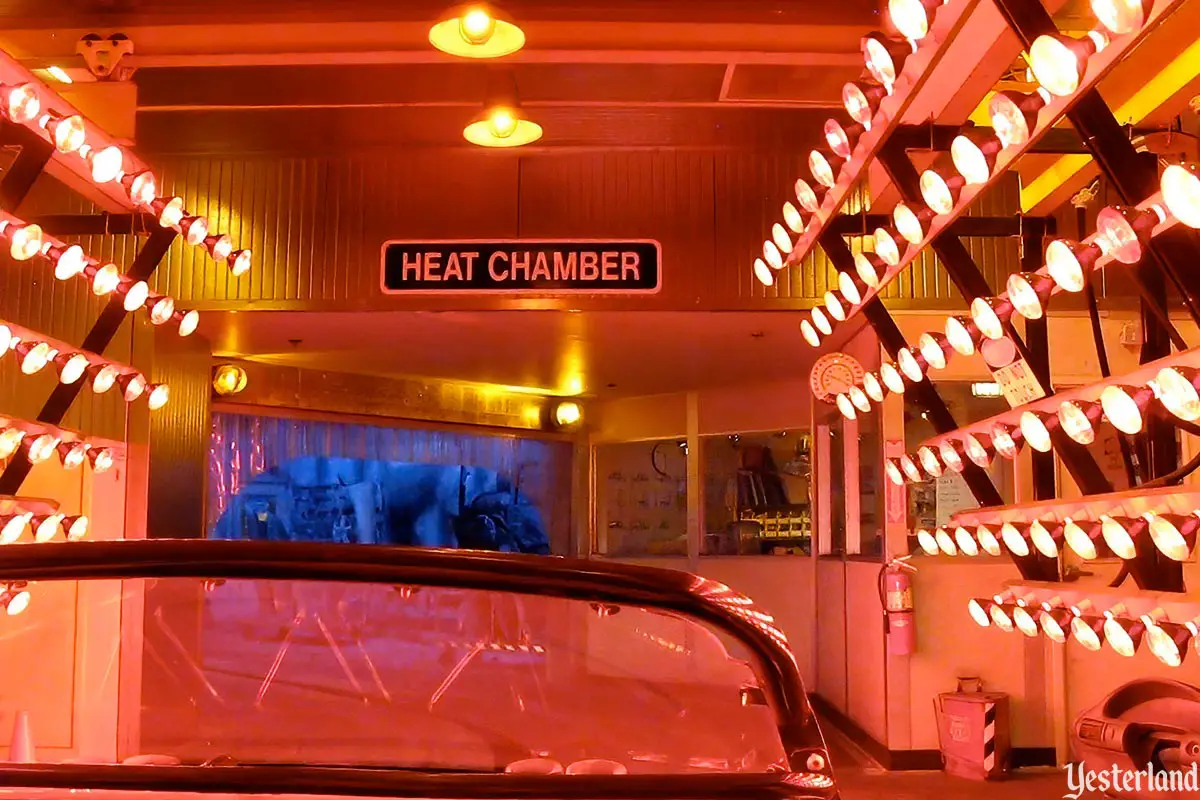
Photo by Werner Weiss, 2007
Environmental Chamber Test 1 |
|||
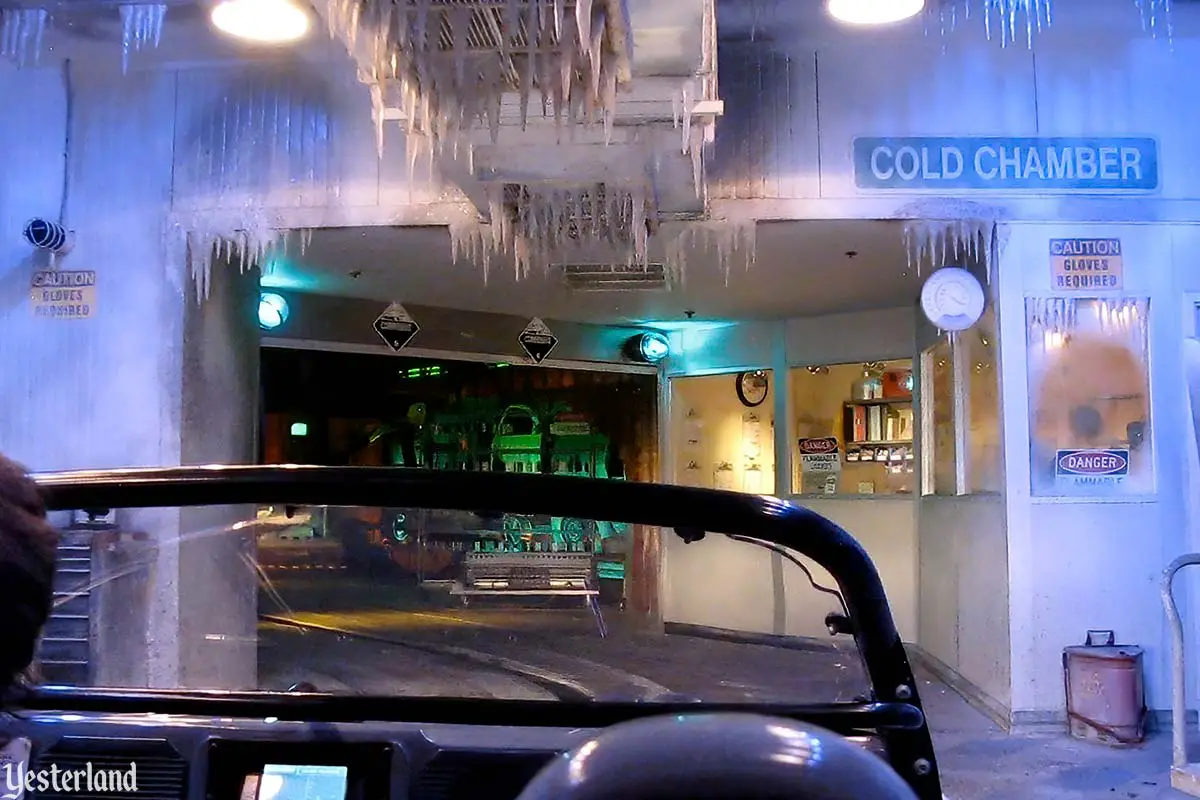
Photo by Werner Weiss, 2007
Environmental Chamber Test 2 |
|||
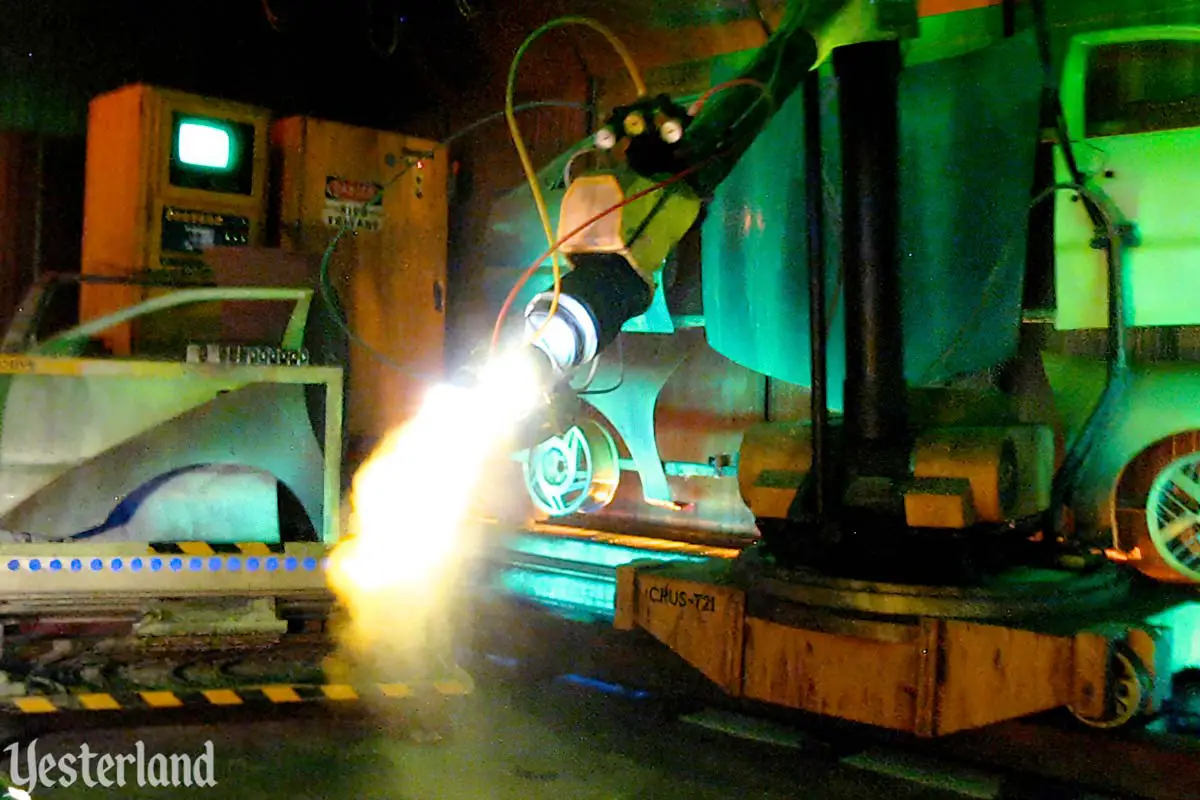
Photo by Werner Weiss, 2009 Environmental Chamber Test 3 |
|||
|
Sherry and Bill follow your progress and coordinate your tests. Bill: Did you remember to turn off those robots? Sherry: Uh. Next comes the road handling test. Sherry: Clear for track course A. Bill: All right, let’s pick up the pace. Sherry: Increasing speed ten percent… twenty percent… thirty percent. Bill: Are you seeing an increase in lateral forces? Sherry: Sure am. Now you’re in a dark tunnel… Yikes! A big truck almost collided with you. Shades of Mr. Toad’s Wild Ride! |
|||
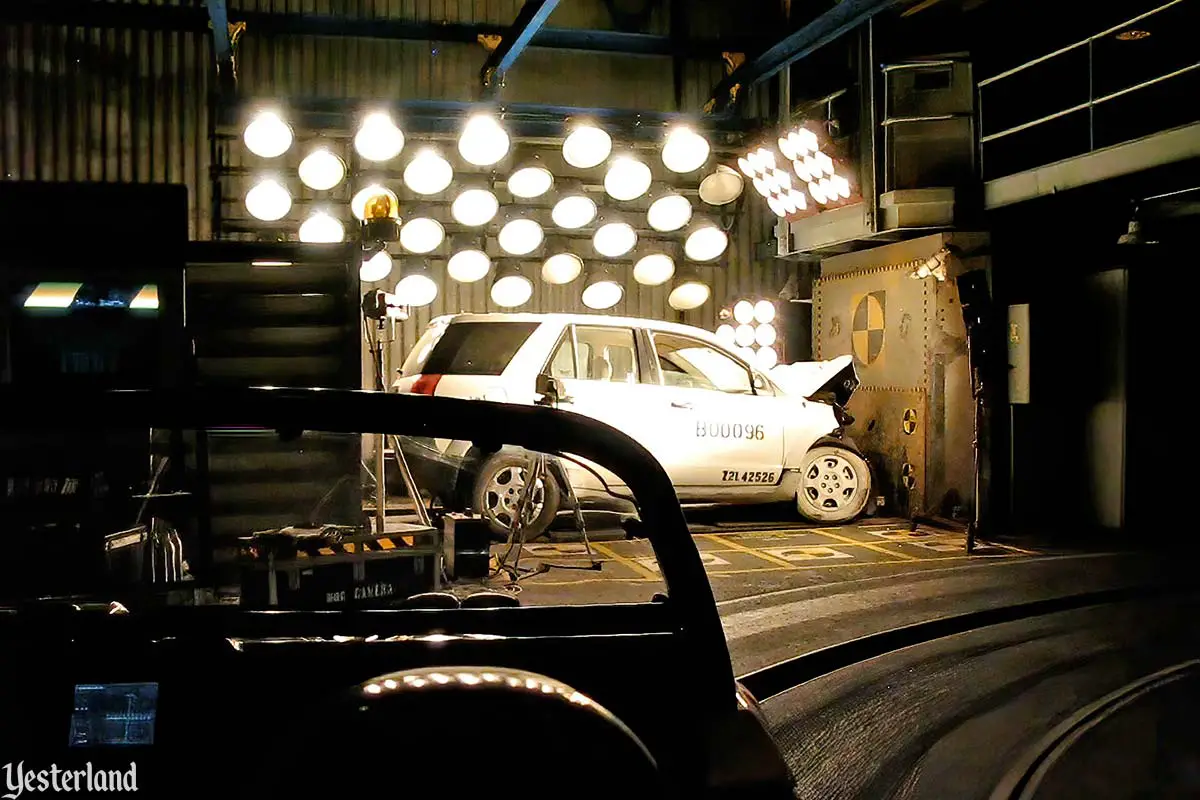
Photo by Werner Weiss, 2009 Crashed cars — and your car is next! |
|||
|
The next test is the barrier test, just like those tests when they send a car with crash test dummies into a solid wall to see how well the car protects its occupants. The sides of the track are littered with wreckage from earlier tests. Hey! Wait a minute. Your car is filled with human beings, not dummies. Is this really a good idea? Announcement: Barrier test in progress. Sherry: Ready for the barrier test. Bill: Check. |
|||
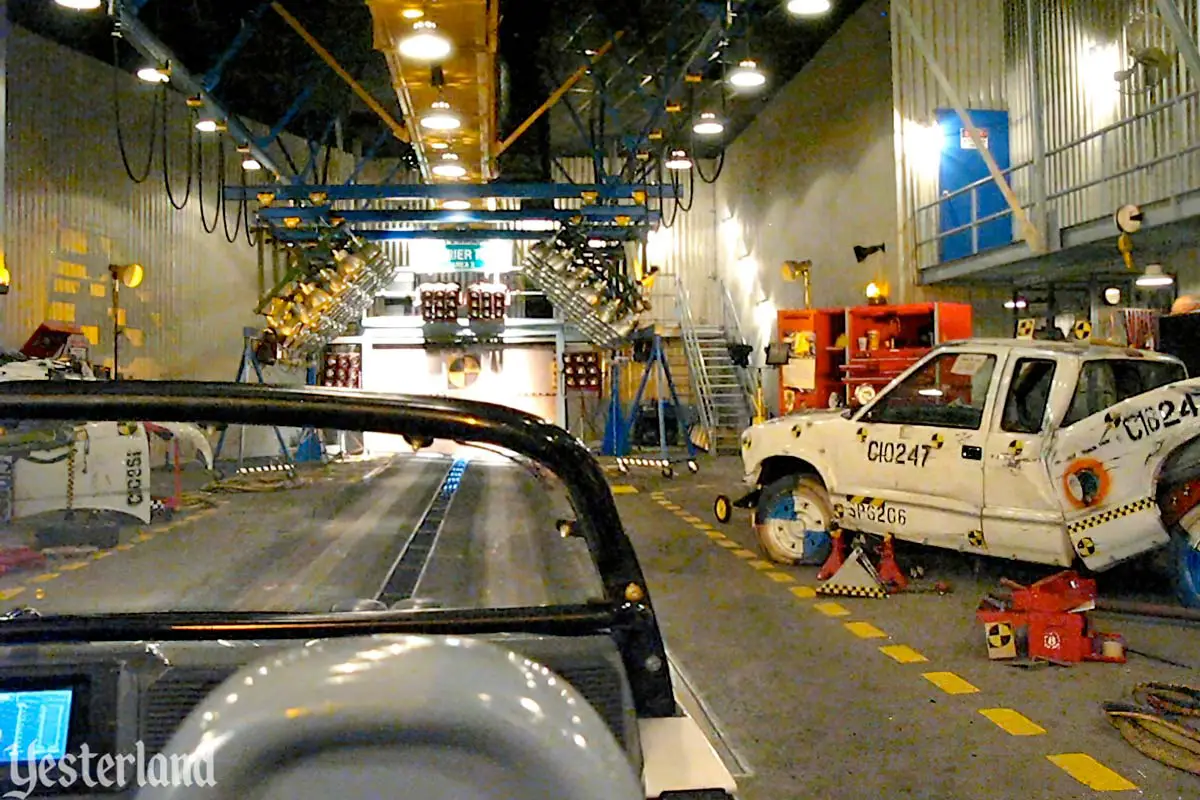
Photo by Werner Weiss, 2007 Approaching the barrier |
|||
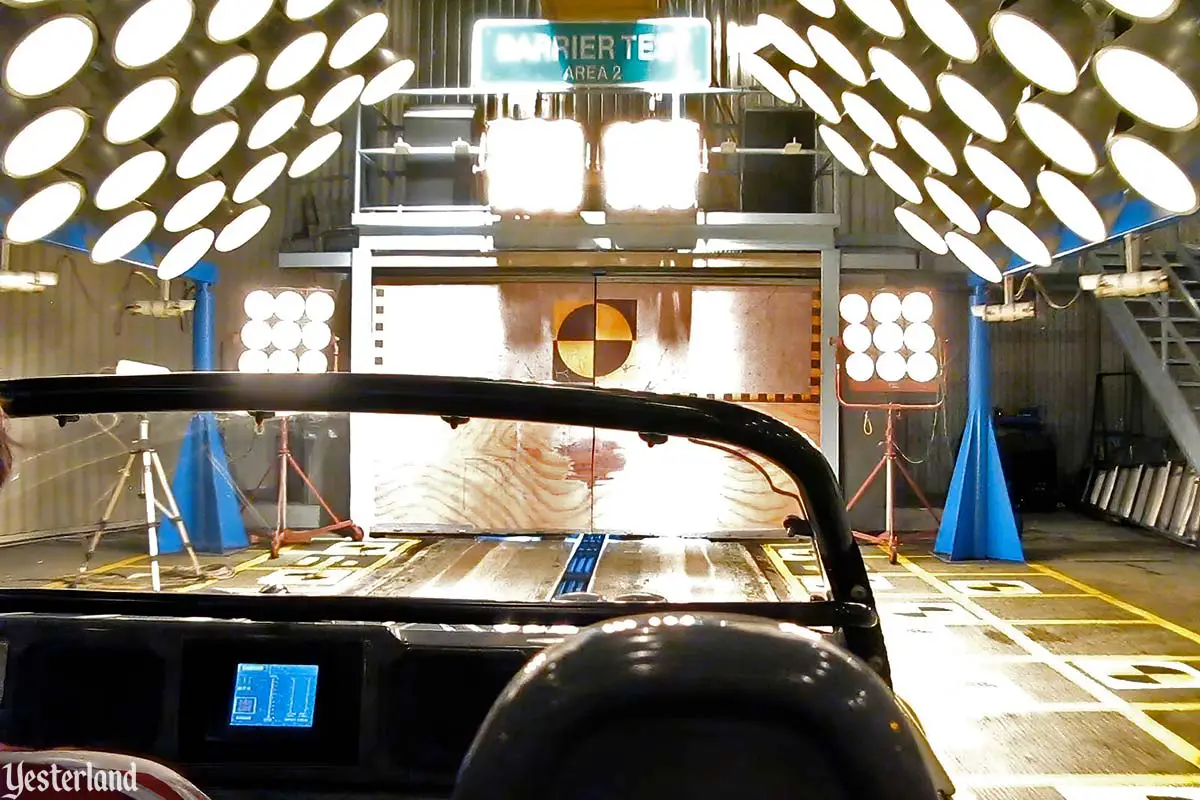
Photo by Werner Weiss, 2009 Ready to crash |
|||
|
You accelerate toward the barrier. Get ready for impact. At the last minute, the barrier flies open like a door, revealing that the track and your vehicle are about to exit from the building. |
|||
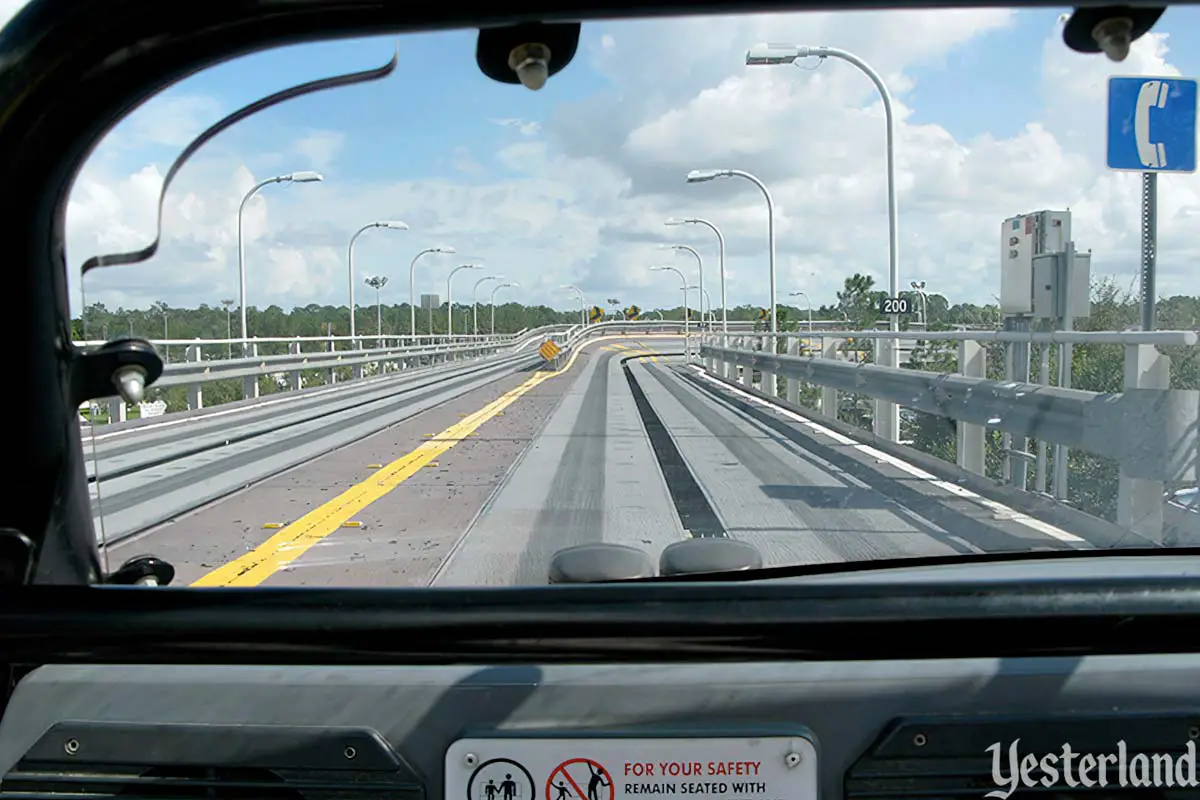
Photo by Werner Weiss, 2007 Let the thrills begin! |
|||
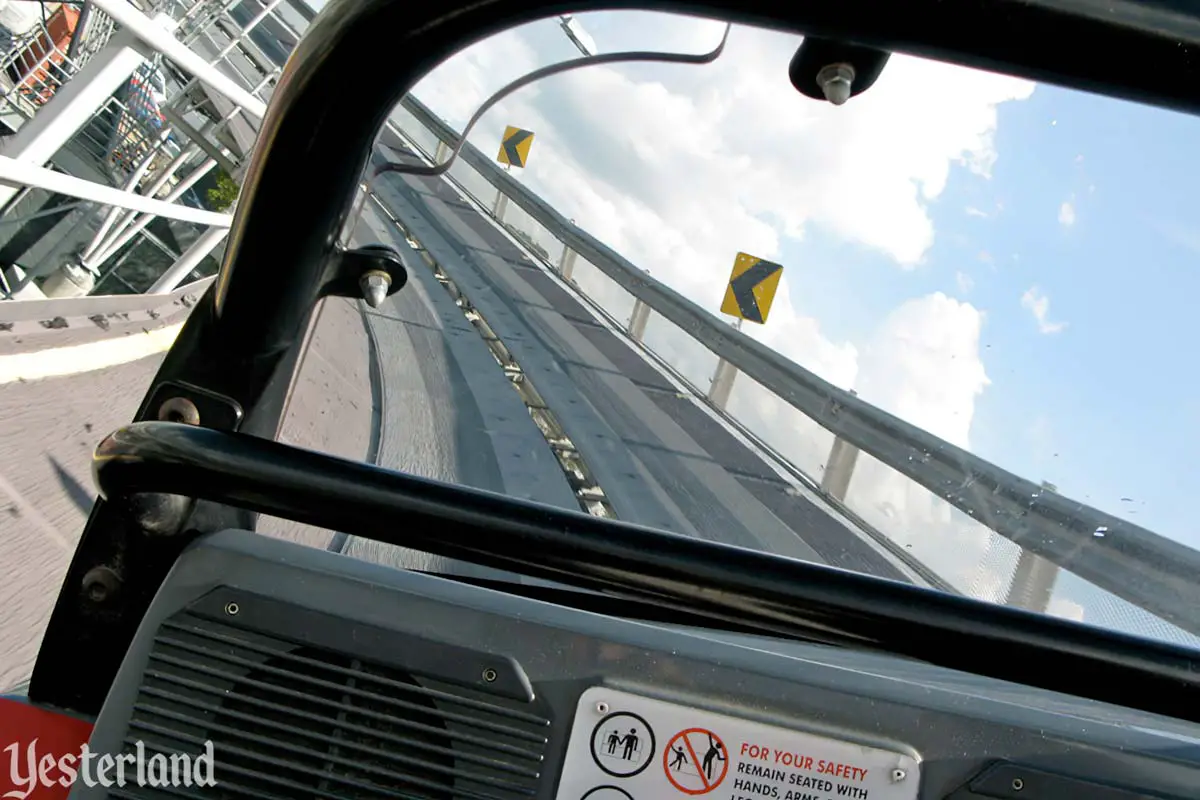
Photo by Werner Weiss, 2007 Banked curve |
|||
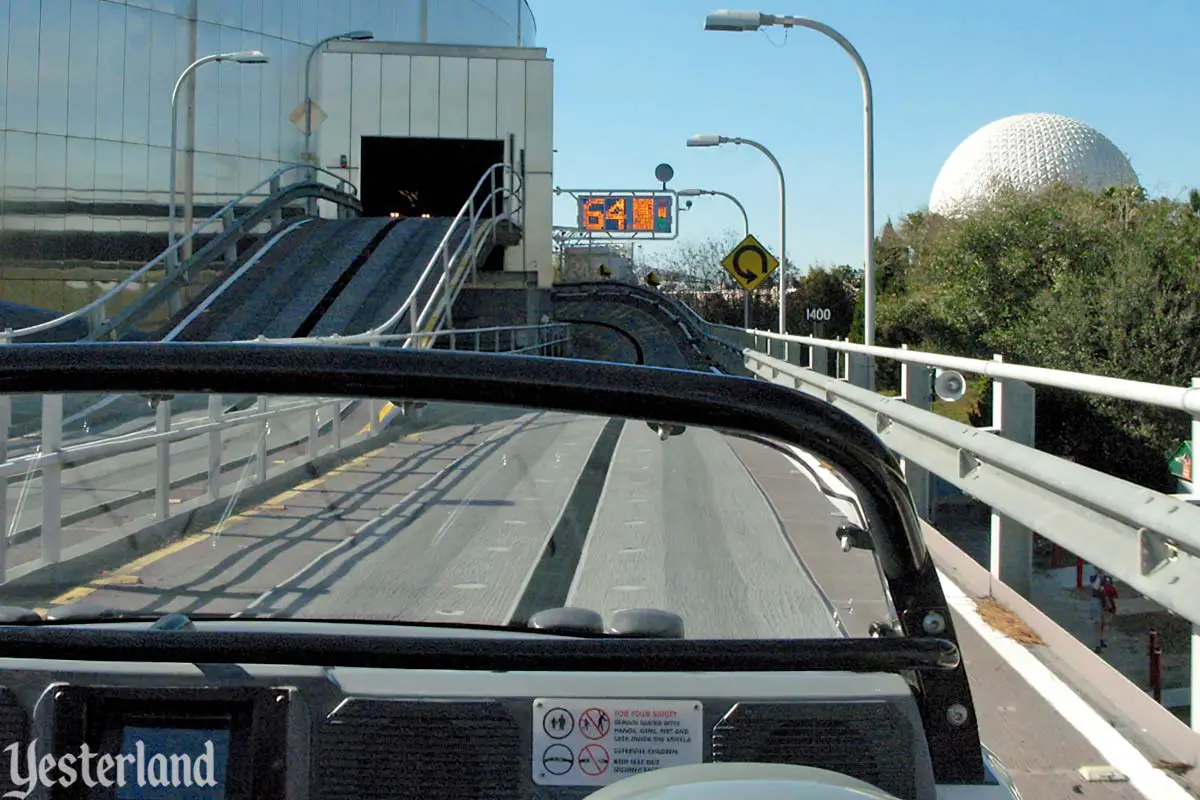
Photo by Werner Weiss, 2007 The fastest ride |
|||
|
Wheeeeee! The barrier test has turned into the performance test. Your car performs admirably through a banked hairpin turn, a straight stretch for acceleration, and a banked curve around part of the round building. The ride is over, but there’s more. |
|||
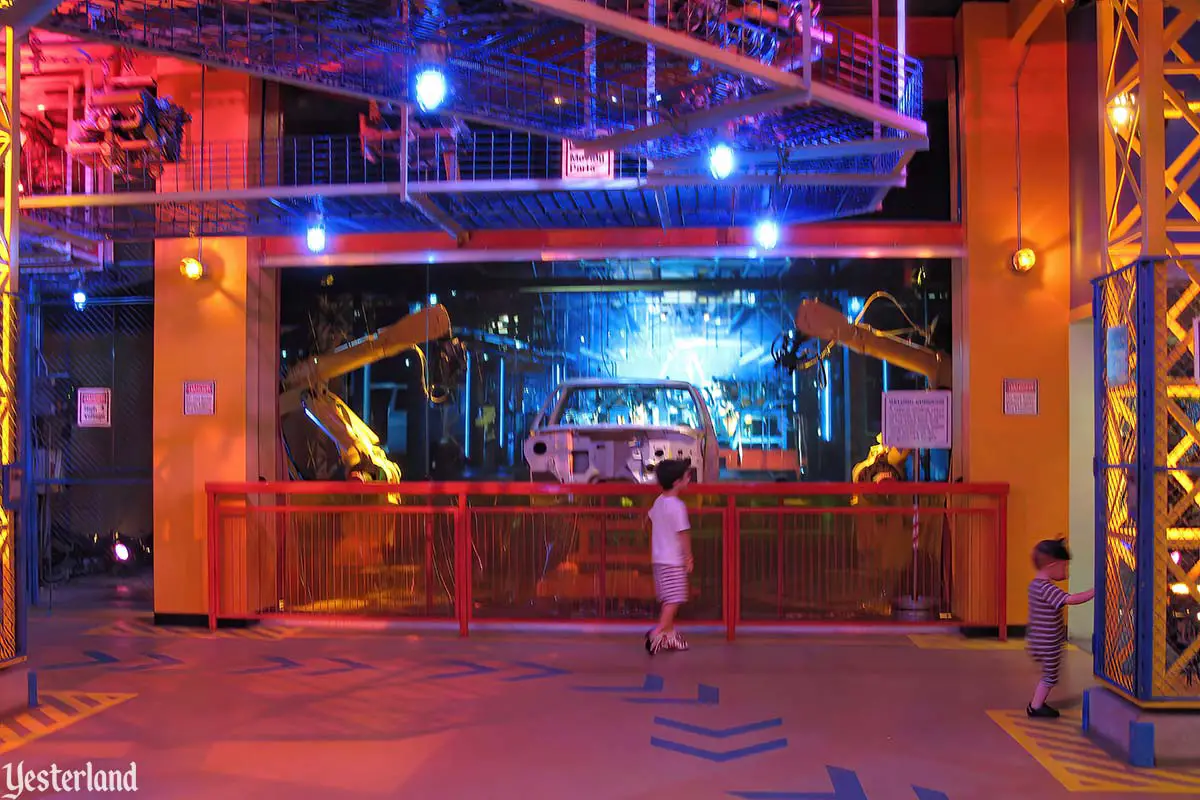
Photo by Werner Weiss, 2009 GM Assembly Experience |
|||
|
The GM Assembly Experience simulates a GM assembly plant. You can admire a die press. A real die press can produce 6,500 tons of pressure and stamp out a new part every four seconds. The GM Assembly Experience is also known as “the part almost everyone just walks through without stopping.” |
|||
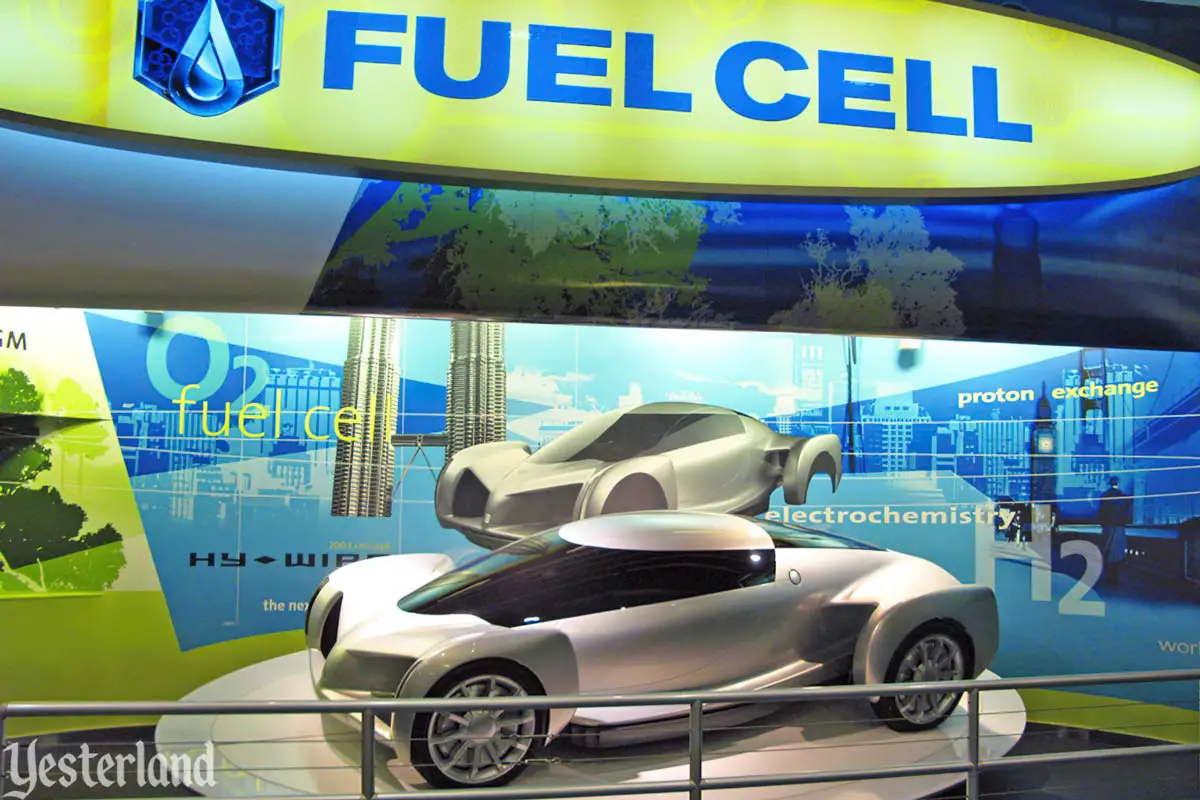
Photo by Werner Weiss, 2009 New technology on display |
|||
|
Next come the technology displays. (These change every few years.) You can learn how GM is innovating. Fuel cells. Hybrids. Fuel from corn. These may find their way to your own car some day. |
|||
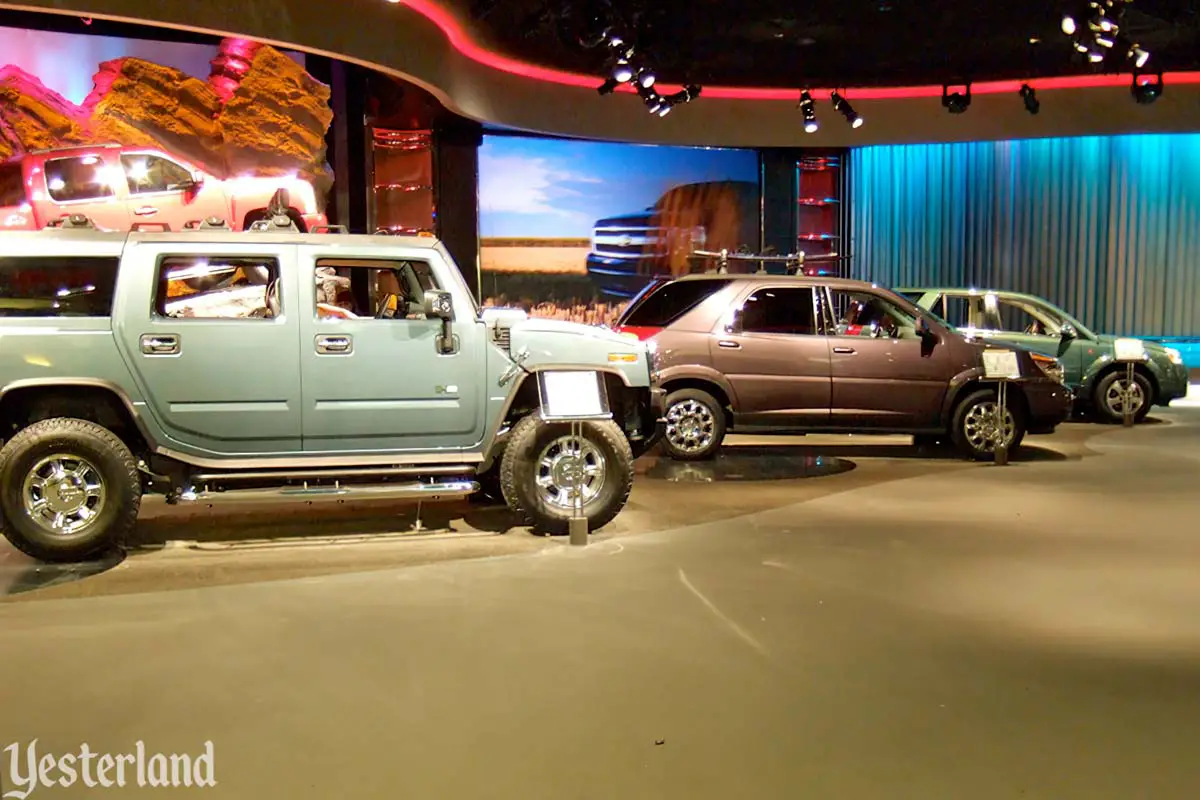
Photo by Allen Huffman, 2006 Showroom |
|||
|
Now it’s time to see the latest cars from the fine brands of General Motors, including Oldsmobile, Pontiac, Saab, Saturn, and Hummer. |
|||
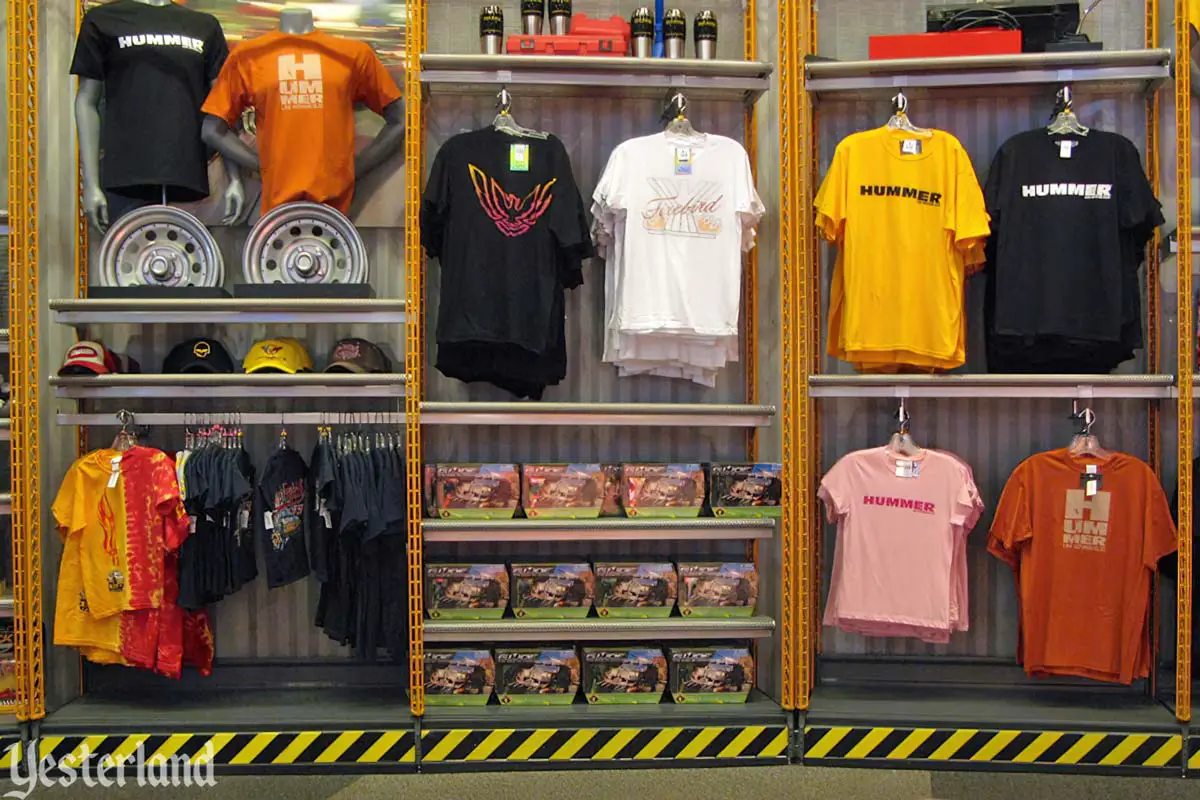
Photo by Werner Weiss, 2009 Hummer shirts |
|||
|
You’re now in Inside Track, the retail shop at the end of your Test Track experience. You survived the ride, but your wallet might not get out of the shop without losing some of its contents. There’s usually some good merchandise here, including things you can’t get anywhere else in the park. |
|||
|
|
|||
|
Test Track presented by General Motors officially opened March 17, 1999, although it had been open to the public, on and off, since the end of 1998. The new GM attraction reused the pavilion that had been Epcot’s first GM attraction. World of Motion, a playful history of transportation, had closed permanently on January 2, 1996. It wasn’t supposed to take three years until the opening of Test Track. |
|||
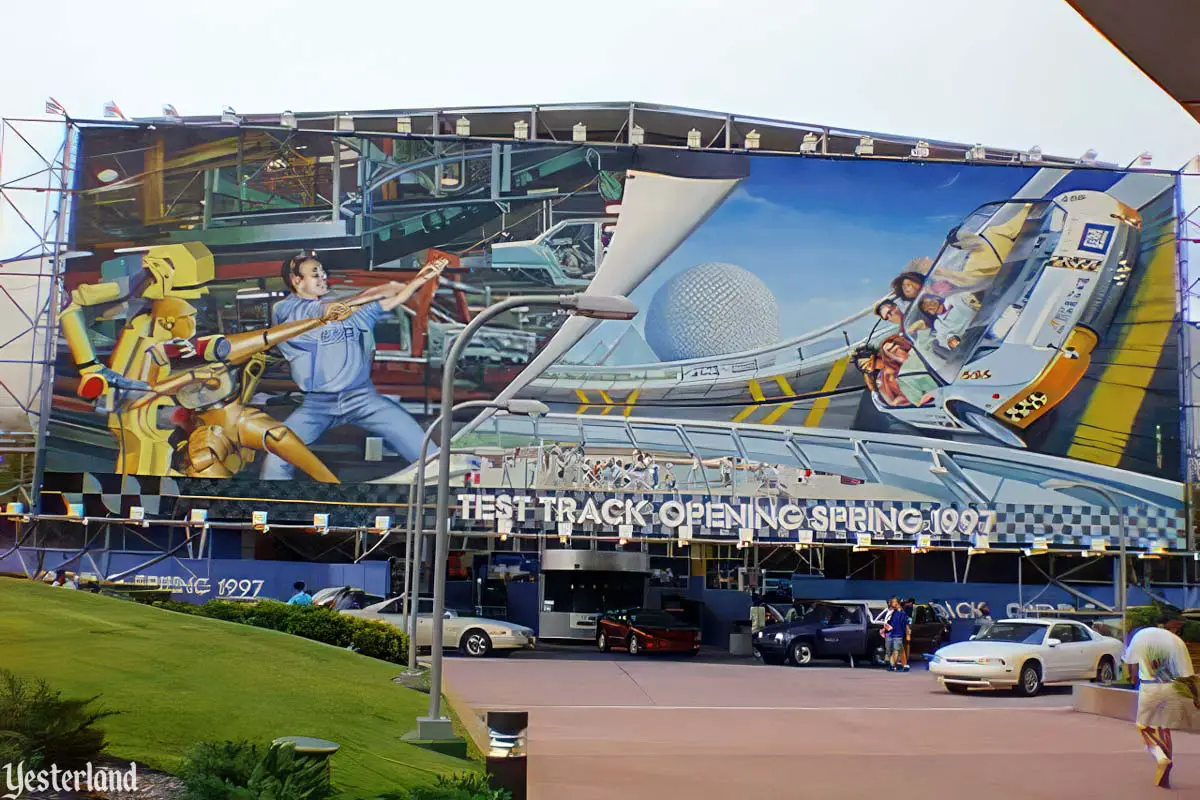
Photo by Allen Huffman, 1996 Test Track construction in 1996 |
|||
|
As early as 1994, Disney revealed that “a ride that would put tourists behind the wheel on a GM test track” would eventually replace World of Motion. After World of Motion closed, the Orlando Sentinel had an article (“Disney on the Fast Track, Epcot Hopes Ride Revs Up Attendance” by Christine Shenot) on February 14, 1996. It began with these paragraphs: The Magic Kingdom has Space Mountain, and Disney-MGM Studios has Tower of Terror. But when it comes to thrill rides, Epcot may soon outshine them. Officials of Walt Disney World and General Motors offered a sneak preview Tuesday of what is being touted as the fastest ride Disney has created. It’s called Test Track, and it’s set to open in the spring of 1997 in the former World of Motion pavilion, which GM has sponsored since Epcot opened in 1982. The cost was not disclosed. “When you come back to this pavilion next spring, you’re going to be wowed,” said Al Weiss, executive vice president and head of Walt Disney World. “These are the most advanced ride vehicles ever developed.” Did you catch the part about the spring of 1997? |
|||
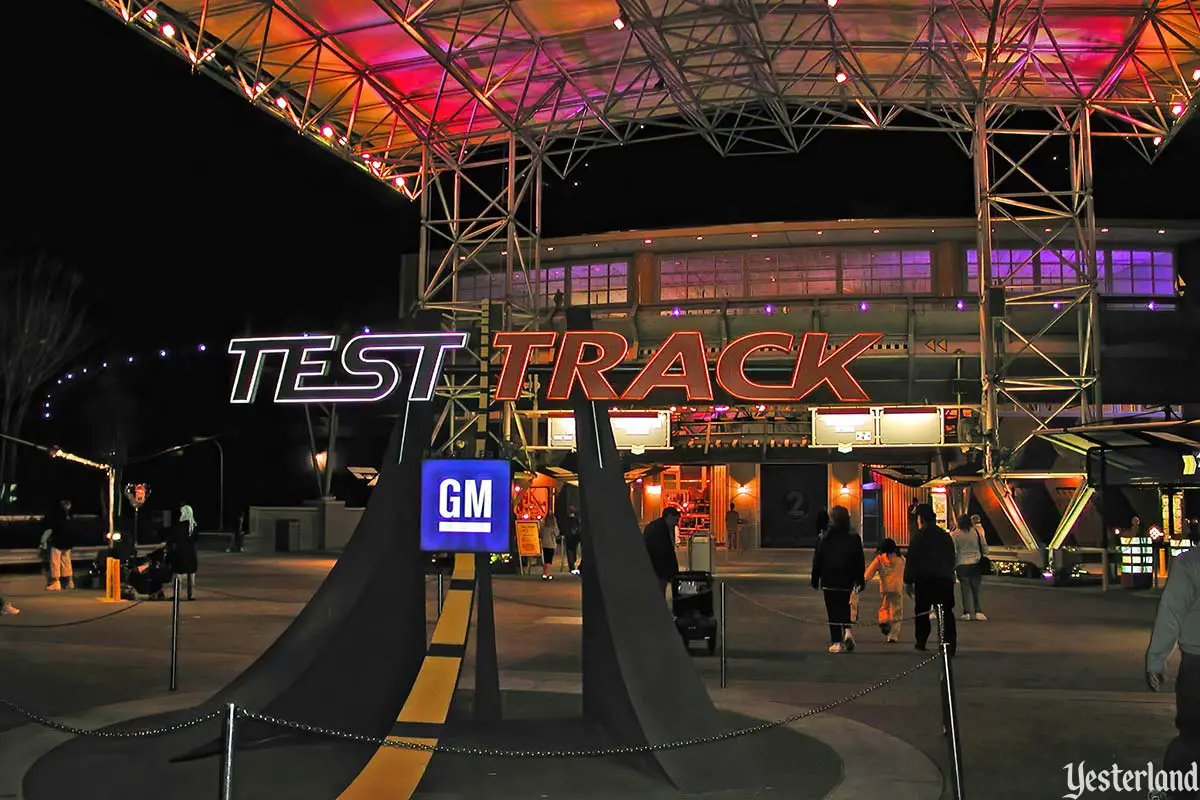
Photo by Werner Weiss, 2002 Test Track at night in 2002 |
|||
|
Then, it seemed whenever the Orlando Sentinel published news about Test Track, it was to report another delay. For example, an article (“Epcot’s 1st Thrill Ride Now on Track to Open in August” by Christine Shenot) on June 2, 1997, started like this: Ever since Walt Disney World and General Motors Corp. unveiled plans for Epcot’s latest attraction — Test Track — the anticipation has been building. Not only will it be the theme park’s first thrill ride, it’ll be the fastest one Disney has ever designed. It’ll also be the longest, covering nearly a mile of track over 5 1/2 minutes. And Test Track features some of the most advanced technology Disney has ever used. But these superlatives haven’t come without glitches. And the attraction, originally set to open last month, is still about three months away from its debut. The reasons for the delays relate to the complexity of the ride, which has made a slow transition from the design phase through testing and manufacturing. One initial problem came in the form of heavy wear and tear on the cars’ tires and differential. That was discovered early and has since been fixed, said George Kalogridis, vice president of Epcot. Another issue is simple logistics. The cars are made in California and shipped in phases. When they arrive, Disney is putting them through meticulous testing at a slower pace than originally planned. “Our No. 1 objective is to make sure that once we do open this to the public it stays open,” Kalogridis said. More than a year later, Test Track had still not opened. An Orlando Sentinel article (“Opening Of Epcot’s Test Track Ride Hits the Brakes - Again” by Cory Lancaster) on August 3, 1998, reported another delay: Just when Walt Disney Co. officials sounded certain that Epcot’s Test Track would open this fall, they confirmed this week the ride has again been delayed. Already more than a year behind schedule, Test Track is part of a General Motors-sponsored pavilion that will show visitors the intensive testing involved in bringing cars to market. Test Track vehicles will propel riders at speeds up to 65 mph through tests of anti-lock brakes, acceleration and the effects of heat, cold and corrosion. Once open, it will be the fastest and longest thrill ride at Walt Disney World. There had been talk that the ride would open as early as October. But that timetable appears to be scrapped, with some Disney officials predicting a spring opening. By now, “spring” meant spring 1999, not spring 1997. When Test Track finally opened, it was a huge success. Unlike World of Motion, which drew big crowds at first, but became a “walk-on” ride with excess capacity after a few years, Test Track continued to pull in crowds — even after a dozen years. Hour-long waits were common in the standby queue. As the years passed, Test Track became somewhat of a relic of the past. The physical ride experience was still great, but the message had grown old and stale since the 1990s. ABS braking was hardly cutting-edge anymore. The 20th century industrial interior had always seemed somewhat out of place in Future World, but eventually screamed Old GM, not New GM. Original Test Track closed April 16, 2012. |
|||
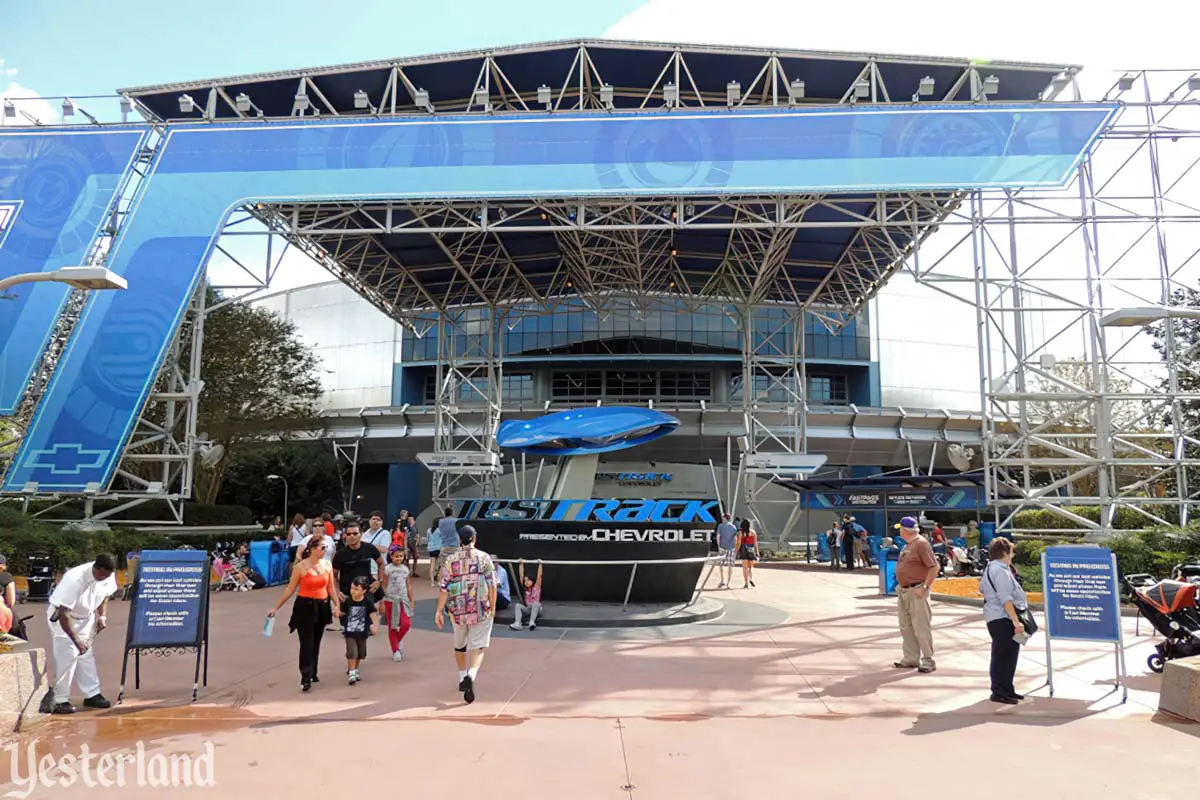
Photo by Werner Weiss, 2012 Test Track presented by Chevrolet, during its soft opening in 2012 |
|||
|
A new version of Test Track, now referred to by fans as Test Track 2.0, opened on December 6, 2012. The sponsor was no longer identified as GM, but its biggest brand, Chevrolet. This version closed permanently on June 17, 2024 to make way for a third version. In June 2025, Disney announced that Test Track would reopen on July 22, 2025. For Test Track 3.0, as fans called it, the sponsor would revert back to General Motors. According to Disney, “This attraction update will debut an all-new musical score, as well as new scenes that highlight technology making our cars smarter and our lives more fun.” General Motors is no longer the world’s largest car manufacturer. In 2009, Toyota took that title from General Motors. In 2024, Toyota, Volkswagen Group, and Hyundai Motor Group all sold more vehicles than General Motors. All three versions have something in common: the track, especially the high-speed portion after it exits from the building. The Imagineers know what to leave alone. |
|||
|
|
Click here to post comments at MiceChat about this article.
© 2025 Werner Weiss — Disclaimers, Copyright, and Trademarks Updated July 4, 2025 |
||